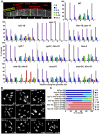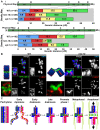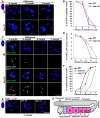Caenorhabditis elegans HIM-18/SLX-4 interacts with SLX-1 and XPF-1 and maintains genomic integrity in the germline by processing recombination intermediates
- PMID: 19936019
- PMCID: PMC2770170
- DOI: 10.1371/journal.pgen.1000735
Caenorhabditis elegans HIM-18/SLX-4 interacts with SLX-1 and XPF-1 and maintains genomic integrity in the germline by processing recombination intermediates
Abstract
Homologous recombination (HR) is essential for the repair of blocked or collapsed replication forks and for the production of crossovers between homologs that promote accurate meiotic chromosome segregation. Here, we identify HIM-18, an ortholog of MUS312/Slx4, as a critical player required in vivo for processing late HR intermediates in Caenorhabditis elegans. DNA damage sensitivity and an accumulation of HR intermediates (RAD-51 foci) during premeiotic entry suggest that HIM-18 is required for HR-mediated repair at stalled replication forks. A reduction in crossover recombination frequencies-accompanied by an increase in HR intermediates during meiosis, germ cell apoptosis, unstable bivalent attachments, and subsequent chromosome nondisjunction-support a role for HIM-18 in converting HR intermediates into crossover products. Such a role is suggested by physical interaction of HIM-18 with the nucleases SLX-1 and XPF-1 and by the synthetic lethality of him-18 with him-6, the C. elegans BLM homolog. We propose that HIM-18 facilitates processing of HR intermediates resulting from replication fork collapse and programmed meiotic DSBs in the C. elegans germline.
Conflict of interest statement
The authors have declared that no competing interests exist.
Figures









Similar articles
-
Interplay between structure-specific endonucleases for crossover control during Caenorhabditis elegans meiosis.PLoS Genet. 2013;9(7):e1003586. doi: 10.1371/journal.pgen.1003586. Epub 2013 Jul 18. PLoS Genet. 2013. PMID: 23874210 Free PMC article.
-
SLX-1 is required for maintaining genomic integrity and promoting meiotic noncrossovers in the Caenorhabditis elegans germline.PLoS Genet. 2012 Aug;8(8):e1002888. doi: 10.1371/journal.pgen.1002888. Epub 2012 Aug 23. PLoS Genet. 2012. PMID: 22927825 Free PMC article.
-
Combinatorial regulation of meiotic holliday junction resolution in C. elegans by HIM-6 (BLM) helicase, SLX-4, and the SLX-1, MUS-81 and XPF-1 nucleases.PLoS Genet. 2013;9(7):e1003591. doi: 10.1371/journal.pgen.1003591. Epub 2013 Jul 18. PLoS Genet. 2013. PMID: 23901331 Free PMC article.
-
Meiotic recombination and the crossover assurance checkpoint in Caenorhabditis elegans.Semin Cell Dev Biol. 2016 Jun;54:106-16. doi: 10.1016/j.semcdb.2016.03.014. Epub 2016 Mar 21. Semin Cell Dev Biol. 2016. PMID: 27013114 Free PMC article. Review.
-
Methods for studying the DNA damage response in the Caenorhabdatis elegans germ line.Methods Cell Biol. 2012;107:321-52. doi: 10.1016/B978-0-12-394620-1.00011-4. Methods Cell Biol. 2012. PMID: 22226529 Review.
Cited by
-
Oocyte aging is controlled by mitogen-activated protein kinase signaling.Aging Cell. 2021 Jun;20(6):e13386. doi: 10.1111/acel.13386. Epub 2021 Jun 1. Aging Cell. 2021. PMID: 34061407 Free PMC article.
-
Slx4 scaffolding in homologous recombination and checkpoint control: lessons from yeast.Chromosoma. 2017 Feb;126(1):45-58. doi: 10.1007/s00412-016-0600-y. Epub 2016 May 10. Chromosoma. 2017. PMID: 27165041 Free PMC article. Review.
-
COSA-1 mediated pro-crossover complex formation promotes meiotic crossing over in C. elegans.Nucleic Acids Res. 2024 May 8;52(8):4375-4392. doi: 10.1093/nar/gkae130. Nucleic Acids Res. 2024. PMID: 38412290 Free PMC article.
-
Identifying Host Factors Associated with DNA Replicated During Virus Infection.Mol Cell Proteomics. 2017 Dec;16(12):2079-2097. doi: 10.1074/mcp.M117.067116. Epub 2017 Oct 2. Mol Cell Proteomics. 2017. PMID: 28972080 Free PMC article.
-
DNA double-strand break repair in Caenorhabditis elegans.Chromosoma. 2011 Feb;120(1):1-21. doi: 10.1007/s00412-010-0296-3. Epub 2010 Nov 5. Chromosoma. 2011. PMID: 21052706 Free PMC article. Review.
References
-
- San Filippo J, Sung P, Klein H. Mechanism of eukaryotic homologous recombination. Annu Rev Biochem. 2008;77:229–257. - PubMed
-
- Krogh BO, Symington LS. Recombination proteins in yeast. Annu Rev Genet. 2004;38:233–271. - PubMed
-
- Lilley DM, White MF. The junction-resolving enzymes. Nat Rev Mol Cell Biol. 2001;2:433–443. - PubMed
Publication types
MeSH terms
Substances
Grants and funding
LinkOut - more resources
Full Text Sources
Molecular Biology Databases
Research Materials

